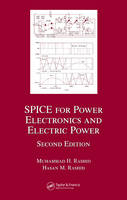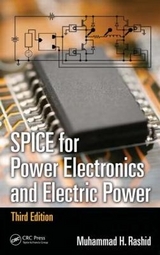
SPICE for Power Electronics and Electric Power, Second Edition
Crc Press Inc (Verlag)
978-0-8493-3418-4 (ISBN)
- Titel erscheint in neuer Auflage
- Artikel merken
To be accredited, a power electronics course should cover a significant amount of design content and include extensive use of computer-aided analysis with simulation tools such as SPICE. Based upon the authors' experience in designing such courses, SPICE for Power Electronics and Electric Power, Second Edition integrates a SPICE simulator with a power electronics course at a junior or senior level. This textbook assumes no prior knowledge of SPICE and introduces the applications of various SPICE commands through numerous examples of power electronic circuits.
The authors emphasize the techniques for power conversions and for quality output waveforms, rather than accurate modeling of power semiconductor devices. This textbook enables students to compare the results with those that are obtained in a classroom environment via simple switch models or devices.
Not only a supplement to any standard textbook on power electronics and power systems, this volume can also be used as a textbook on SPICE. It suggests laboratory experiments and design problems, and presents complete laboratory guidelines for each experiment. This text can also be used as a laboratory manual for power electronics, with its design problems serving as assignments for a design-oriented simulation laboratory.
Introduction
Introduction
Descriptions of SPICE
Types of Spice
Types of Analysis
Limitations of PSpice
Descriptions of Simulation Software Tools
PSpice Platform
PSpice A/D
PSpice Schematics
OrCAD Capture
PSpice Schematics vs. OrCAD Capture
SPICE Resources
Web Sites with Free SPICE Models
Web Sites with SPICE Models
SPICE and Circuit Simulation Information Sites
Engineering Magazines with SPICE Articles
Suggested Reading
Circuit Descriptions
Introduction
Input Files
Nodes
Element Values
Circuit Elements
Element Models
Sources
Output Variables
Types of Analysis
PSpice Output Commands
Format of Circuit Files
Format of Output Files
Examples of PSpice Simulations
PSpice Schematics
PSpice Schematics Layout
PSpice A/D
Probe
Importing Microsim Schematics in OrCAD Capture
Suggested Reading
Problems
Defining Output Variables
Introduction
DC Sweep and Transient Analysis
Voltage Output
Current Output
Power Output
AC Analysis
Voltage Output
Current Output
Output Markers
Noise Analysis
Summary
Voltage and Current Sources
Introduction
Sources Modeling
Pulse Source
Typical Statements
Piecewise Linear Source
Typical Statement
Sinusoidal Source
Typical Statements
Exponential Source
Typical Statements
Single-Frequency Frequency Modulation Source
Typical Statements
Independent Sources
Independent Voltage Source
Typical Statements
Independent Current Source
Typical Statements
Schematic Independent Sources
Dependent Sources
Polynomial Source
Typical Model Statements
Voltage-Controlled Voltage Source
Typical Statements
Current-Controlled Current Source
Typical Statements
Voltage-Controlled Current Source
Typical Statements
Current-Controlled Voltage Source
Typical Statements
Schematic Dependent Sources
Behavioral Device Modeling
VALUE
Typical Statements
TABLE
Typical Statements
LAPLACE
Typical Statements
FREQ
Typical Statements
Summary
Suggested Reading
Problems
Passive Elements
Introduction
Modeling of Elements
Some Model Statements
Operating Temperature
Some Temperature Statements
RLC Elements
Resistor
Some Resistor Statements
Capacitor
Some Capacitor Statements
Inductor
Some Inductor Statements
Magnetic Elements and Transformers
Linear Magnetic Circuits
Nonlinear Magnetic Circuits
Lossless Transmission Lines
Switches
Voltage-Controlled Switch
Current-Controlled Switch
Time-Dependent Switches
Time-Dependent Close Switch
Time-Dependent Open Switch
Summary
Suggested Reading
Problems
SPICE Dot Commands
Introduction
Models
.MODEL (Model)
.SUBCKT (Subcircuit)
.ENDS (End of Subcircuit)
.FUNC (Function)
.GLOBAL (Global)
.LIB (Library File)
.INC (Include File)
.PARAM (Parameter)
.STEP (Parametric Analysis)
Types of Output
.PRINT (Print)
.PLOT (Plot)
.PROBE (Probe)
Probe Statements
Probe Output
.WIDTH (Width)
Operating Temperature and End of Circuit
Options
DC Analysis
.OP (Operating Point)
.NODESET (Nodeset)
.SENS (Sensitivity Analysis)
.TF (Small-Signal Transfer Function)
.DC (DC Sweep)
AC Analysis
Noise Analysis
Transient Analysis
.IC (Initial Transient Conditions)
.TRAN (Transient Analysis)
Fourier Analysis
Monte Carlo Analysis
Sensitivity and Worst-Case Analysis
Summary
Suggested Reading
Problems
Diode Rectifiers
Introduction
Diode Model
Diode Statement
Diode Characteristics
Diode Parameters
Modeling Zener Diodes
Tabular Data
Diode Rectifiers
Laboratory Experiments
Experiment DR.1
Single-Phase Full-Wave Center-Tapped Rectifier
Experiment DR.2
Single-Phase Bridge Rectifier
Experiment DR.3
Three-Phase Bridge Rectifier
Summary
Suggested Reading
Design Problems
DC-DC Converters
Introduction
DC Switch Chopper
BJT SPICE Model
BJT Parameters
Examples of BJT Choppers
MOSFET Choppers
MOSFET Parameters
Examples of MOSFET Choppers
IGBT Model
Laboratory Experiment
Experiment TP.1
DC Buck Chopper
Experimental TP-2
DC Boost Chopper
Summary
Suggested Reading
Design Problems
Pulse-Width-Modulated Inverters
Introduction
Voltage-Source Inverters
Current-Source Inverters
Laboratory Experiments
Experiment PW.1
Single-Phase Half-Bridge Inverter
Experiment PW.2
Single-Phase Full-Bridge Inverter
Experiment PW.3
Single-Phase Full-Bridge Inverter with PWM Control
Experiment PW.4
Experiment PW.5
Three-Phase Bridge Inverter
`Experiment PW.6
Single-Phase Current-Source Inverter
Experiment PW.7
Three-Phase Current-Source Inverter
Summary
Suggested Reading
Design Problems
Resonant-Pulse Inverters
Introduction
Resonant-Pulse Inverters
Zero-Current Switching Converters (ZCSC)
Zero-Voltage Switching Converter (ZVSC)
Laboratory Experiments
Experiment RI.1
Single-Phase Half-Bridge Resonant Inverter
Experiment RI.2
Single-Phase Full-Bridge Resonant Inverter
Experiment RI.3
Push-Pull Inverter
Experiment RI.4
Parallel Resonant Inverter
Experiment RI.5
ZCSC
Experiment RI.6
ZVSC
Summary
Suggested Reading
Design Problems
Controlled Rectifiers
Introduction
AC Thyristor Model
Controlled Rectifiers
Examples of Controlled Rectifiers
Switched Thyristor DC Model
GTO Thyristor Model
Example of Forced-Commutated Rectifiers
Laboratory Experiments
Experiment TC.1
Single-Phase Half-Wave Controlled Rectifier
Experiment TC.2
Single-Phase Full-Wave Controlled Rectifier
Experiment TC.3
Three-Phase Full-Wave Controlled Rectifier
Summary
Suggested Reading
Design Problems
AC Voltage Controllers
Introduction
AC Thyristor Model
AC Voltage Controllers
Examples of AC Voltage Controllers
Laboratory Experiments
Experiment AC.1
Single-Phase AC Voltage Controller
Experiment AC.2
Three-Phase AC Voltage Controller
Summary
Suggested Reading
Design Problems
Control Applications
Introduction
Op-Amp Circuits
DC Linear Models
AC Linear Models
Nonlinear Macromodels
Control Systems
Signal Conditioning
Closed-Loop Current Control
Suggested Reading
Problems
Characteristics of Electrical Motors
Introduction
DC Motor Characteristics
Induction Motor Characteristics
Suggested Reading
Problems
Difficulties
Introduction
Large Circuits
Running Multiple Circuits
Large Outputs
Long Transient Runs
Convergence
DC Sweep
Bias-Point Calculation
Transient Analysis
Analysis Accuracy
Negative Component Values
Power Switching Circuits
Model Parameters of Diodes and Transistors
Error Tolerances
Snubbing Resistor
Quasi-Steady-State Condition
Floating Nodes
Nodes with Fewer than Two Connections
Voltage Source and Inductor Loops
Running PSpice Files on Spice
Running Spice Files on PSpice
Using Earlier Version of Schematics
Suggested Reading
Problems
APPENDIX A
Running PSpice on PCs
Installing PSpice Software in PCs
Creating Input Circuit Files
Running DOS Commands
PSpice Default Symbol Libraries
| Erscheint lt. Verlag | 2.11.2005 |
|---|---|
| Reihe/Serie | Electrical and Computer Engineering |
| Zusatzinfo | 106 equations; 25 Tables, black and white; 490 Illustrations, black and white |
| Verlagsort | Bosa Roca |
| Sprache | englisch |
| Maße | 152 x 229 mm |
| Gewicht | 930 g |
| Themenwelt | Technik ► Elektrotechnik / Energietechnik |
| ISBN-10 | 0-8493-3418-7 / 0849334187 |
| ISBN-13 | 978-0-8493-3418-4 / 9780849334184 |
| Zustand | Neuware |
| Haben Sie eine Frage zum Produkt? |
aus dem Bereich



